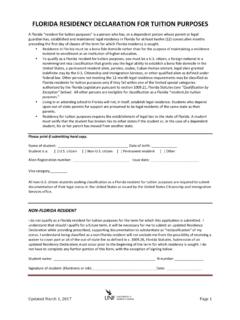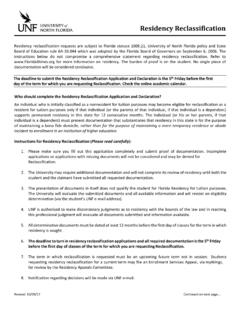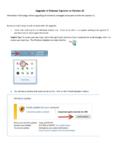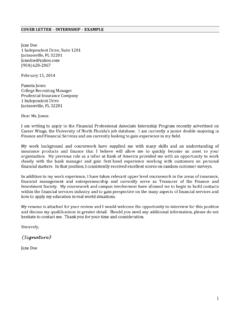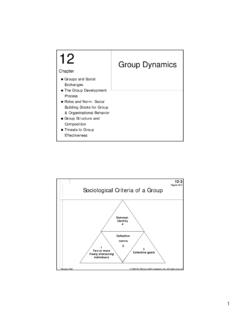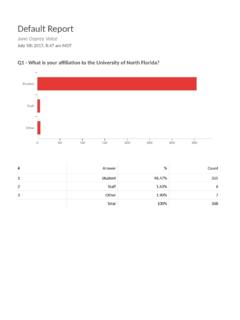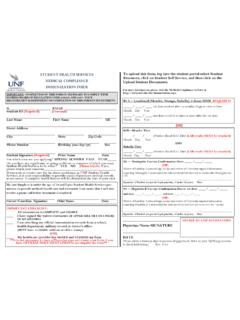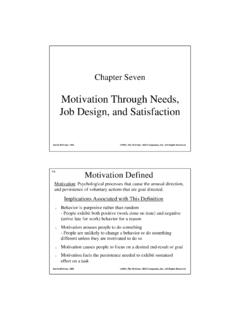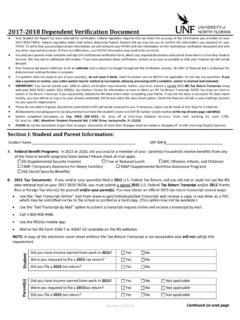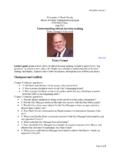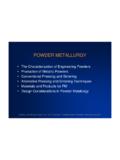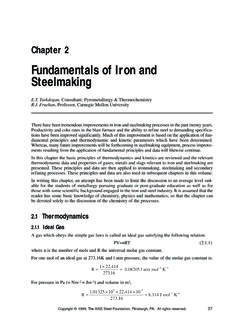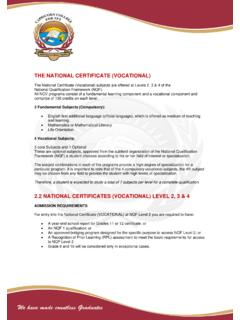Transcription of Chapter Three
1 Chapter ThreeFundamentals ofOrganization StructureA Sample Organization ChartChiefAccountantBudgetAnalystVice PresidentFianancePlantSuperintendentMain tenanceSuperintendentVice PresidentManufacturingTrainingSpecialist BenefitsAdministratorDirectorHuman ResourcesCEOThe Relationship of Organization Design to Efficiency vs. Learning OutcomesHorizontal OrganizationDesigned for LearningVertical OrganizationDesigned for EfficiencyDominantStructuralApproachHori zontal structure is dominant Shared tasks, empowerment Relaxed hierarchy, few rules Horizontal, face-to-face communication Many teams and task forces Decentralized decision makingVertical structure is dominant Specialized tasks Strict hierarchy, many rules Vertical communication and reporting systems Few teams, task forces or integrators Centralized decision makingLadder of Mechanisms for Horizontal Linkage and CoordinationHIGHLOWLOWI nformation SystemsDirect ContactTask ForcesFull-time IntegratorsTeamsAmount of HorizontalCoordination RequiredCost of Coordination in Time and Human ResourcesH IGHP roject Manager Locationin the StructurePresidentFinanceDepartmentFinan cialAccountantBudgetAnalystManagementAcc ountantEngineeringDepartmentProductDesig nerDraftspersonElectricalDesignerMarketi ngDepartmentMarketResearcherAdvertisingS pecialistMarketPlannerPurchasingDepartme ntBuyerBuyerBuyerProject ManagerNewProduct BProject ManagerNewProduct AProject ManagerNewProduct CTeams Used for Horizontal Coordination at Rodney Hunt CompanyWater Control EngineerEngineering Vice PresCustomer Service,Purchasing.
2 Production ManagerFoundry General SupervisorManufacturing Vice PresMachine ShopGeneral SupervisorShipping and YardSupervisorWater Control ManagerMarketing Vice MachineryExport ManagerAdvertising ManagerTextile MachineryChief EngineerStainless SteelGeneral SupervisorTextile MachineryDomestic Sales ManagerPresidentWater Control Product TeamTextile Product TeamStructural Design Options for Grouping Employees into DepartmentsProductDivision 1 ProductDivision 2 ProductDivision 3 CEOE ngineeringMarketingManufacturingCEOF unctionalGroupingDivisionalGroupingSourc e: Adapted from David Nadler and Michael Tushman,Strategic Organization Design(Glenview, Ill.: Scott Foresman, 1988), and Weaknesses of Functional Organization StructurebSTRENGTHS: Allows economies of scale within functional departments Enables in-depth knowledge and skill development Enables organization to accomplish functional goals Is best with only one or few productsbWEAKNESSES: Slow response time to environmental changes May cause decisions to pile on top, hierarchy overload Leads to poor horizontal coordination among departments Results in less innovation Involves restricted view of organizational goalsSource: Adapted from Robert Duncan, What Is the Right Organization Structure?
3 Decision Tree Analysis Provides the Answer, Organizational Dynamics (Winter 1979): and Weaknesses of Divisional Organization StructurebSTRENGTHS: Suited to fast change in unstable environment Leads to client satisfaction because product responsibility and contact points are clear Involves high coordination across functions Allows units to adapt to differences in products, regions, clients Best in large organizations with several products Decentralizes decision-makingbWEAKNESSES: Eliminates economies of scale in functional departments Leads to poor coordination across product lines Eliminates in-depth competence and technical specialization Makes integration and standardization across product lines difficultSource: Adapted from Robert Duncan, What Is theRight Organization Structure? Decision Tree AnalysisProvides the Answer, Organizational Dynamics(Winter 1979): from Functional Structure to Divisional Structure at Info-TechR&DManufacturingAccountingMarke tingInfo-TechPresidentFunctionalStructur eR&DMfgAcctgMktgElectronicPublishingR&DM fgAcctgMktgOfficeAutomationR&DMfgAcctgMk tgVirtualRealityInfo-TechPresidentDivisi onalStructureStructural Design Options for Grouping Employees (Continued)Multi-focusedGroupingCEOM anufacturingMarketingProductDivision 2 ProductDivision 1 Source: Adapted from David Nadler and Michael Tushman, Strategic Organization Design(Glenview, Ill.)
4 : Scott Foresman, 1988), Design Options for Grouping Employees (Continued)HorizontalGroupingCEOF inanceHuman ResourcesCoreProcess 2 CoreProcess 1 Source: Adapted from David Nadler and Michael Tushman,Strategic Organization Design(Glenview, Ill.: Scott Foresman, 1988), Structurefor Apple ComputerCEOS teve JobsAppleEuropeApplePacificFranceApplePr oductsFar EastJapanAustraliaAppleAmericasCanadaLat inAmerica/CaribbeanSalesService andMarketingto RegionsSource: AProductManager BProductManager CProductManager DDirectorof ProductOperationsDesignVicePresidentMfgV icePresidentMarketingVicePresidentContro llerProcure-mentManagerPresidentDual-Aut hority Structure in a Matrix OrganizationbSTRENGTHS: Achieves coordination necessary to meet dual demands from customers Flexible sharing of human resources across products Suited to complex decisions and frequent changes in unstable environment Provides opportunity for both functional and product skill development Best in medium-sized organizations with multiple productsbWEAKNESSES: Causes participants to experience dual authority, which can be frustrating and confusing Means participants need good interpersonal skills and extensive training Is time consuming.
5 Involves frequent meetings and conflict resolution sessions Will not work unless participants understand it and adopt collegial rather than vertical-type relationships Requires great effort to maintain power balanceStrengths and Weaknesses of Matrix Organization StructureSource: Adapted from Robert Duncan, What Is the RightOrganization Structure? Decision Tree Analysis Provides theAnswer, Organizational Dynamics (Winter 1979): Structure forWorldwide Steel SalesVicePresidentOpen DieBusiness ProductsBusiness & AxlesBusiness FunctionsHorizontal FunctionsA Horizontal StructureTeam3 Team2 Team1 TopManagementTeamTeam3 Team2 Team1 CustomerCustomerProcessOwnerProcessOwner TestingProductPlanningResearchMarketAnal ysisNew Product Development and Logistics ProcessSources: Based on Frank Ostroff,The Horizontal Organization, (New York:Oxford University Press, 1999); John A. Byrne, The Horizontal Corporation, Business Week,December 20, 1993, 76-81; and Thomas A.
6 Stewart, The Search for the Organization of Tomorrow, Fortune, May 19, 1992, and Weaknesses of Horizontal StructurebSTRENGTHS: Flexibility and rapid response to changes in customer needs Directs the attention of everyone toward the production and delivery of value to the customer Each employee has a broader view of organizational goals Promotes a focus on teamwork and collaboration common commitment to meeting objectives Improves quality of life for employees by offering them the opportunity to share responsibility, make decisions, and be accountable for outcomes bWEAKNESSES: Determining core processed to organize around is difficult and time-consuming Requires changes in culture, job design, management philosophy, and information and reward systems Traditional managers may balk when they have to give up power and authority Requires significant training of employees to work effectively in a horizontal team environment Can limit in-depth skill developmentSources:Based on Frank Ostroff, The Horizontal Organization: What the Organization of the Future Looks Like and How It Delivers Value to Customers, (New York: Oxford University Press, 1999);and Richard L.
7 Daft, Organization Theory and Design, 6thed.,(Cincinnati, Ohio: South-Western College Publishing, 1998) StructurePart 1. Sun Petrochemical ProductsPresidentTechnologyVicePresident FinancialServicesVice :Based on Linda S. Ackerman, Transition Management: An In-Depth Look at Managing Complex Change, Organizational Dynamics (Summer 1982): 46-66;and Frank Ostroff, The Horizontal Organization, (New York: Oxford University Press, 1999), Fig. , StructurePart 2. Ford Customer Service DivisionDirector andProcess OwnerDirector andProcess OwnerSources:Based on Linda S. Ackerman, Transition Management:An In-Depth Look at Managing Complex Change, Organizational Dynamics(Summer 1982): 46-66; and Frank Ostroff, The Horizontal Organization, (New York: Oxford University Press, 1999), Fig. , andCommunicationFinanceVice President andGeneral ManagerTeamsTeamsDirector andProcess OwnerTeamsTechnical Support GroupVehicle Service and Programs GroupParts Supply / Logistics GroupFunctionalStructureHorizontal StructureTeamsTeamsOrganization Contextual Variables that Influence StructureStructure(learning )EnvironmentChapters 4, 5 CultureChapter 9 SizeChapter 8 Strategy,GoalsChapter 2 TechnologyChapters 6,7 Sources:Adapted from Jay R.
8 Galbraith,Competing with Flexible Lateral Organizations, 2nded.(Reading, Mass.: Addison-Wesley, 1994), ; Jay R. Galbraith, Organization Design(Reading, Mass.: Addison-Wesley, 1977), Ch. 1. The Relationship of Structure to Organization s Need for Efficiency vs. LearningHorizontalStructureDominantStruc turalApproachHorizontal: Coordination Change Learning Innovation FlexibilityVertical: Control Efficiency Stability ReliabilityMatrixStructureDivisionalStru ctureFunctional withcross-functionalteams, integratorsFunctionalStructureSymptoms of Structural DeficiencybDecision making is delayed or lacking in qualitybThe organization does not respond innovatively to a changing environmentbToo much conflict from departments being at cross purposes is evident
